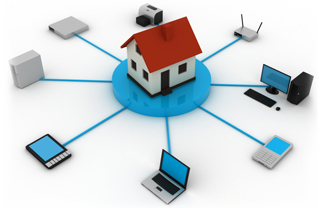Routers and network switches / hubs are all parts of a network wired Ethernet. They are all used to hook up computers together. The difference between a network switch and a router is a router is more sophisticated.
Network Router Characteristics
It is a network device. It is small with a box-like shape which computers can link up to. Each one has several ports at the rear or front. These serve as the connector points for electric power and computers. The device uses LED lights to indicate status. The physical appearance of routers and hubs are similar, but the former differs in its internal features.
The standard router is made to link up several LANs to a WAN. They function as transitional points for traffic on networks. These devices target network addresses, identify the source by checking the packets and receive packets. Once the information is processed, the packets are sent to their destination.
Comparing Routers and Hubs
These are made specifically to connect the Internet (WAN) to your home (LAN). By comparison, hubs and switches have to assign a computer as a gateway to the Web. That device has to have a couple of network adapters. One will be for the Internet WAN and the other for home LAN.
With a router, every computer in your home linked to the device is regarded as peers. The device also performs all the necessary functions for the gateway.
Other Features of Broadband Routers
They have more features than the standard variety. For instance, they have support for firewalls for added security. Integrated DHCP server is also included. Most importantly, they have a built-in Ethernet switch. This makes it possible to have many hubs linked to them. It is a good way to increase a LAN. This way it is simpler to install more Ethernet devices.
Technically speaking, wireless networks also rely on these devices. However, there is no concept of wireless hubs. However, a Wi-Fi access point can be likened to a wired hub. The majority of these devices utilize an Internet Protocol (IP) router (wired or wireless). The reason is IPs are considered standards in an OSI network.
Information about Hubs and Switches
Network hubs are hardware parts that hook several computers into a single local area network. In technical terms it functions at an OSI model’s Data Link Layer (layer 2). Technically they are considered “smarter” than switches, although in general usage is regarded as the same.
Switches are able to check data packets as they are being sent to it. They know each packet’s device source and destination. They can forward the packets. Because messages can be transmitted just to the linked device, the switch preserves bandwidth. Device connection support varies according to the model. The consumer level types offer 4 to 8 Ethernet level connections. A hub is connected with each other.
Other Information
These components are available online. You need to research the components thoroughly. There are several brands to choose from. This is where knowledge of the technical features becomes important. You will not get confused by the jargon used or be impressed by every technical detail stated. You will also know what questions to ask.
As you can see, the difference between a network switch and a router is quite telling. Although they are all parts of an Ethernet connection, it’s still vital to know that you know the facts.
Neil is a free lancer writer and content builder of http://www.tech-faq.com/
